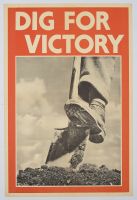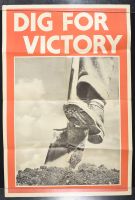Dig For Victory
Halfsheet,
Dig for Victory" was a propaganda campaign launched in the United Kingdom during World War II to encourage citizens to grow their own food.
The campaign was initiated by the British Ministry of Agriculture at the outbreak of the war in 1939. The goal was to combat food shortages caused by German U-boat attacks on merchant shipping, which prevented food imports from reaching the country.
Key aspects of the campaign:
Encouraged Self-Sufficiency: The campaign urged people to transform gardens, flowerbeds, public parks, and other available land into vegetable patches and allotments.
Increased Food Production: By 1943, the number of allotments in Britain had nearly doubled to 1.4 million, and they were producing over a million tons of vegetables annually. By 1945, Britain was producing 75% of its own food, up from 25% before the war.
Boosted Morale: "Dig for Victory" posters, along with other media like radio programs and instructional leaflets, helped foster a sense of national unity and a feeling that everyone could contribute to the war effort from the home front.
Freed Up Resources: By reducing the need for food imports, the campaign freed up shipping space for essential war materials like weapons and ammunition
Dig for Victory" was a propaganda campaign launched in the United Kingdom during World War II to encourage citizens to grow their own food.
The campaign was initiated by the British Ministry of Agriculture at the outbreak of the war in 1939. The goal was to combat food shortages caused by German U-boat attacks on merchant shipping, which prevented food imports from reaching the country.
Key aspects of the campaign:
Encouraged Self-Sufficiency: The campaign urged people to transform gardens, flowerbeds, public parks, and other available land into vegetable patches and allotments.
Increased Food Production: By 1943, the number of allotments in Britain had nearly doubled to 1.4 million, and they were producing over a million tons of vegetables annually. By 1945, Britain was producing 75% of its own food, up from 25% before the war.
Boosted Morale: "Dig for Victory" posters, along with other media like radio programs and instructional leaflets, helped foster a sense of national unity and a feeling that everyone could contribute to the war effort from the home front.
Freed Up Resources: By reducing the need for food imports, the campaign freed up shipping space for essential war materials like weapons and ammunition
Disclaimer
The object and/or subject of this report is private property. This page is for informational purposes only. Unless clearly stated otherwise, all conservation and restoration has been performed by Poster Mountain (PM) or Los Angeles Paper Group (LAPG)I) PM-LAPG has not knowingly withheld any significant information from its evaluation report and to the best of its knowledge all statements and evaluations in this report are true and correct.
II) PM-LAPG stated in the Evaluation Report its own personal, unbiased and professional analysis, opinions and conclusions, which are subject to the assumptions and limited conditions in this evaluation report as set forth hereinabove.
III) PM-LAPG has no present or prospective interests in the property which is the subject matter of this report and it has no present or prospective personal interests or bias with respect to the participants in this matter.
IV) PM-LAPG and its employment and/or compensation for performing this evaluation or any future anticipated evaluation was not conditioned on any agreement or understanding, written or otherwise, that it would report (or present analysis in support) as predetermined specific authenticity, a predetermined evaluation that favors the cause of any party or the attainment of any specific result or occurrence of a specific subsequent event, such as value or marketability.
V) PM-LAPG prepared all opinions and conclusions about the subject property that were set forth in this Evaluation Report. If it has relied on significant evaluation assistance from any individual or individuals in the performance of this evaluation or the appropriation of this evaluation report, PM-LAPG has named such individuals and disclosed the specific task performed in this evaluation report. PM-LAPG certifies that any individual so named is qualified to the same extent as PM to perform the task. PM-LAPG has not authorized anyone to make a change to any item in this evaluation report, therefore, any change made to this evaluation is unauthorized and PM-LAPG will not take responsibility for it.
VI) The Client may not disclose or distribute this Evaluation Report to any potential purchasers of the subject property without first obtaining PM-LAPG's prior written consent. This consent must be obtained before this evaluation report may be disclosed or distributed to any other party, including, but not limited to, the public through advertising, public relations, news, sales, or other media.


